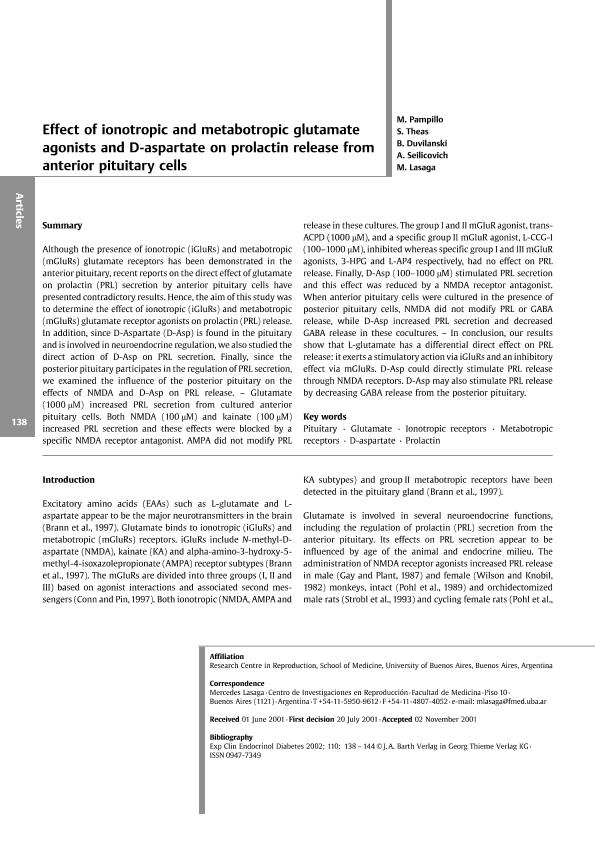Mostrar el registro sencillo del ítem
dc.contributor.author
Pampillo, M.
dc.contributor.author
Theas, Maria Susana

dc.contributor.author
Duvilanski, Beatriz Haydee

dc.contributor.author
Seilicovich, Adriana

dc.contributor.author
Lasaga, Mercedes Isabel

dc.date.available
2021-03-08T13:08:44Z
dc.date.issued
2002-03
dc.identifier.citation
Pampillo, M.; Theas, Maria Susana; Duvilanski, Beatriz Haydee; Seilicovich, Adriana; Lasaga, Mercedes Isabel; Effect of ionotropic and metabotropic glutamate agonists and D-aspartate on prolactin release from anterior pituitary cells; Johann Ambrosius Barth Verlag Medizinverlage Heidelberg Gmbh; Experimental Clinical Endocrinology & Diabetes; 110; 3; 3-2002; 138-144
dc.identifier.issn
0947-7349
dc.identifier.uri
http://hdl.handle.net/11336/127707
dc.description.abstract
Although the presence of ionotropic (iGluRs) and metabotropic (mGluRs) glutamate receptors has been demonstrated in the anterior pituitary, recent reports on the direct effect of glutamate on prolactin (PRL) secretion by anterior pituitary cells have presented contradictory results. Hence, the aim of this study was to determine the effect of ionotropic (iGluRs) and metabotropic (mGluRs) glutamate receptor agonists on prolactin (PRL) release. In addition, since D-Aspartate (D-Asp) is found in the pituitary and is involved in neuroendocrine regulation, we also studied the direct action of D-Asp on PRL secretion. Finally, since the posterior pituitary participates in the regulation of PRL secretion, we examined the influence of the posterior pituitary on the effects of NMDA and D-Asp on PRL release. - Glutamate (1000 μM) increased PRL secretion from cultured anterior pituitary cells. Both NMDA (100 μM) and kainate (100 μM) increased PRL secretion and these effects were blocked by a specific NMDA receptor antagonist. AMPA did not modify PRL release in these cultures. The group I and II mGluR agonist, trans-ACPD (1000 μM), and a specific group II mGluR agonist, L-CCG-I (100-1000 μM), inhibited whereas specific group I and III mGluR agonists, 3-HPG and L-AP4 respectively, had no effect on PRL release. Finally, D-Asp (100-1000 μM) stimulated PRL secretion and this effect was reduced by a NMDA receptor antagonist. When anterior pituitary cells were cultured in the presence of posterior pituitary cells, NMDA did not modify PRL or GABA release, while D-Asp increased PRL secretion and decreased GABA release in these cocultures. - In conclusion, our results show that L-glutamate has a differential direct effect on PRL release: it exerts a stimulatory action via iGluRs and an inhibitory effect via mGluRs. D-Asp could directly stimulate PRL release through NMDA receptors. D-Asp may also stimulate PRL release by decreasing GABA release from the posterior pituitary.
dc.format
application/pdf
dc.language.iso
eng
dc.publisher
Johann Ambrosius Barth Verlag Medizinverlage Heidelberg Gmbh

dc.rights
info:eu-repo/semantics/openAccess
dc.rights.uri
https://creativecommons.org/licenses/by-nc-sa/2.5/ar/
dc.subject
D-ASPARTATE
dc.subject
GLUTAMATE
dc.subject
LONOTROPIC RECEPTORS
dc.subject
METABOTROPIC RECEPTORS
dc.subject
PITUITARY
dc.subject
PROLACTIN
dc.subject.classification
Neurociencias

dc.subject.classification
Medicina Básica

dc.subject.classification
CIENCIAS MÉDICAS Y DE LA SALUD

dc.title
Effect of ionotropic and metabotropic glutamate agonists and D-aspartate on prolactin release from anterior pituitary cells
dc.type
info:eu-repo/semantics/article
dc.type
info:ar-repo/semantics/artículo
dc.type
info:eu-repo/semantics/publishedVersion
dc.date.updated
2020-09-11T19:46:38Z
dc.journal.volume
110
dc.journal.number
3
dc.journal.pagination
138-144
dc.journal.pais
Alemania

dc.description.fil
Fil: Pampillo, M.. Universidad de Buenos Aires. Facultad de Medicina. Departamento de Biología Celular e Histología. Centro de Investigación en Reproducción; Argentina
dc.description.fil
Fil: Theas, Maria Susana. Consejo Nacional de Investigaciones Científicas y Técnicas. Oficina de Coordinación Administrativa Houssay; Argentina. Universidad de Buenos Aires. Facultad de Medicina. Departamento de Biología Celular e Histología. Centro de Investigación en Reproducción; Argentina
dc.description.fil
Fil: Duvilanski, Beatriz Haydee. Consejo Nacional de Investigaciones Científicas y Técnicas. Oficina de Coordinación Administrativa Houssay; Argentina. Universidad de Buenos Aires. Facultad de Medicina. Departamento de Biología Celular e Histología. Centro de Investigación en Reproducción; Argentina
dc.description.fil
Fil: Seilicovich, Adriana. Consejo Nacional de Investigaciones Científicas y Técnicas. Oficina de Coordinación Administrativa Houssay; Argentina. Universidad de Buenos Aires. Facultad de Medicina. Departamento de Biología Celular e Histología. Centro de Investigación en Reproducción; Argentina
dc.description.fil
Fil: Lasaga, Mercedes Isabel. Universidad de Buenos Aires. Facultad de Medicina. Departamento de Biología Celular e Histología. Centro de Investigación en Reproducción; Argentina. Consejo Nacional de Investigaciones Científicas y Técnicas. Oficina de Coordinación Administrativa Houssay; Argentina
dc.journal.title
Experimental Clinical Endocrinology & Diabetes

dc.relation.alternativeid
info:eu-repo/semantics/altIdentifier/url/https://www.thieme-connect.com/products/ejournals/abstract/10.1055/s-2002-29092
dc.relation.alternativeid
info:eu-repo/semantics/altIdentifier/doi/http://dx.doi.org/10.1055/s-2002-29092
Archivos asociados
